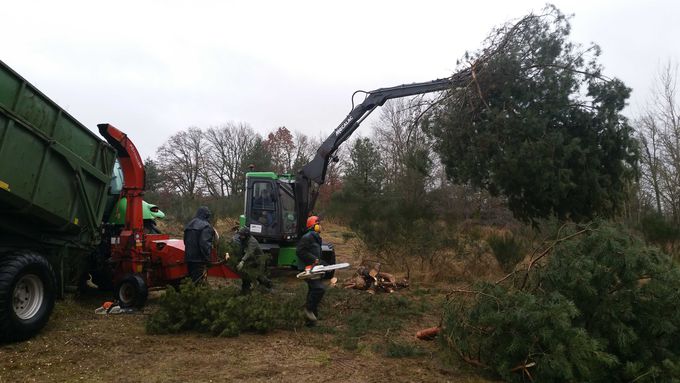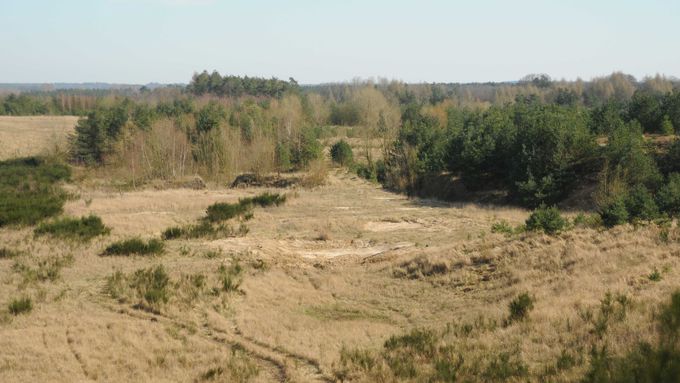Wood works in winter 2019/2020. © Lutz von der Heyde
main content
Project of the month
#12/2021 SAND PIT BREEZE
Conservation and restoration of a habitat complex in the district of Lüneburg
The approximately 20-hectare area of the ‘Sandgrube Breetze’ is one of the most important open land habitats in the district of Lüneburg. It is characterized by uneven, partly steep slopes. Young stands of pines occur in alternation with dry lean succession fields and lean dry grasslands. In addition to protected whitish hair-grass meadows and wood small-reed meadows, broom, hawthorn and blackthorn bushes characterize the structurally rich area.
The sandpit has a dry warm climate which is ideal for the sand lizard (Lacerta agilis) and other, partly endangered, species. Also natterjack toad (Bufo calamita), red-backed shrike (Lanius collurio) and the wryneck (Jynx torquilla) can be found there. The open sand areas also serve as a habitat for wild bees and bumble-bees. In addition, more than 800 butterfly and moth species have been identified in recent surveys.
Due to increasing scrub encroachment and succession because of abandonment of use, however, this valuable habitat complex has come under pressure in recent years, so that sand lizards and natterjack toads are now present only in small populations. The Lower Nature Conservation Authority of the district of Lüneburg and the LIFE IP ‘Atlantic Region DE’ saw the need for action and, together with a local biologist who has been familiar with the area for many years, developed a concept for the preservation and expansion of this ecologically diverse area.
Initially, the natural rejuvenation of pine trees was pushed back on the site in order to enlarge and connect open land areas. In individual cases, solitary pine trees or small groups could be left standing as lookout perches for the wryneck. Some pines were overturned with their roots after they had been cut. In this way, the root plates - as well as newly established stacks of deadwood - can serve as hiding places for insects and the ‘Reptile of the Year 2020 and 2021’, the sand lizard. Dense stands of trees and shrubs have been cleared, with hawthorn and blackthorn bushes deliberately left untouched as nesting places for the red-backed shrike.
In addition to succession, emerging dominant stands of wood small-reed were identified as a problem for the habitat complex. In these dense stands, less competitive plant species have hardly any chance. For this reason, particularly dense stands of wood small-reed were mowed, with the mown material being removed. In addition, the plant cover was partially stripped off. Caution was required here, as the seeds of the less competitive species which are still present in the soil should remain in the area if possible. This measure also served to create structures for sand lizards and wild bees by way of example. By removing the topsoil of a slope, wild bees could be additionally supported.
In order to promote the natterjack toad population in the area, a start was made on creating five temporary small waterbodies as spawning grounds. In areas with loamy parts, sinks were dug for this purpose. The measure already showed first successes in summer 2021: After two years without reproduction of the natterjack toad in the sand pit, about one thousand metamorphosed natterjack toads were able to leave the waters this year.
In order to keep this landscape permanently open and to prevent a recolonization by trees and bushes, a one-off creation of habitat structures is not sufficient. A long-term management concept is needed to ensure that structural diversity is preserved. For this reason, a fence was constructed in the western part of the area to allow for regular grazing. The Lower Nature Conservation Authority of the district of Lüneburg has developed a grazing concept for this. First of all, after the removal of trees and shrubs it is important to prevent the reappearance of woody plants and the wood small-reed. Since summer 2020, sheep have therefore been grazing on the area.
Related topics
Further links
- Reptile of the Year 2020 and 2021: The Sand Lizard – Deutsche Gesellschaft für Herpetologie und Terrarienkunde (DGHT), AG Feldherpetologie und Artenschutz (in German) (external link opens in a new window)
- District of Lüneburg – Nature and forests (in German) (external link opens in a new window)
- Further information about the sand lizard (in German) (external link opens in a new window)





